Designing and Building an Intelligent Pavement Management System for Urban Road Networks
Abstract
1. Introduction
- Under different weather conditions, such as dry, wet, dusty, and snowy road surfaces, or combinations of these variables, a vehicle’s maneuvering and braking abilities are affected by the skid resistance of the pavement, which is directly related to tire–road friction.
- Friction measures are usually included in the scope of a PMS because of its importance in and relevance to road occurrences.
- The advantages of using smart sensors implanted in tires are similar to those of using a tool to support sophisticated vehicle control, but smart sensors also provide a practical method of determining in real-time the amount of friction on a roadway section while travelling.
- Data: It is essential for an intelligent system to perform that the raw material that a smart infrastructure needs is present.
- Analytics: Information analysis is essential to obtain reliable data for decision making.
- Feedback: An intelligent system must have a data feedback loop. This feedback is visible when data is collected, utilized, and used to improve the system’s functionality.
- Adaptability: Smart systems can adjust to current demands and accommodate future needs.
- To build an urban outdoor point cloud dataset labeled pointwise on a large scale for SUIMS in terms of pavements.
- To investigate an integrated road network consisting of the positions (via 3D LiDAR point cloud) and attribute information of the detected cracks, collected via RGB images.
- To produce a detailed 3D intelligent pavement management system based on city stakeholders’ decision-making preferences.
2. Literature Review
- Gathering data on the road’s geometry and the mechanical properties of the materials that make up the asphalt pavement’s layers.
- Simulating the road’s pavement in a BIM environment.
- Putting in place a decision support system for the administration of maintenance procedures. The decision support system should be created with the goal of determining the ideal moment for an intervention at the analysis’s time.
- Geometrical data of the pavements, captured via 3D mobile LiDAR and RGB photos using a vehicle outfitted with the necessary equipment for the distress detection phase.
- Attribute data of each road section, consisting of general project information, design criteria, traffic data (vehicle/day), climate data, structure, and layering data, including material properties for the pavement design phase.
2.1. Data
2.1.1. Geometrical Data
- MLS and SICK sensors (abbreviation for an object between sensor and background [20]) were used to create Oakland 3D, an outdoor point cloud, in the first instance of its kind [21]. With a low point density, the LiDAR device used here is mono fiber. This dataset has around 1.6 million points, sorted into forty-four classes. However, only five classifications were examined in the literature: vegetation, wire, pole, ground, and facade. Because this dataset is small, lightweight networks can be constructed and evaluated.
- The data file of iQmulus [22] was obtained using Stereopolis II [23] in Paris from the IQmulus and TerraMobilita Contest. A monofiber LiDAR called “Riegl LMS-Q120i” was applied to capture the spatial information data. There are around three hundred million points within the entire dataset divided into twenty-two classes. Consequently, for the contest dataset, just one sample was shared with the public: 12 million observations in a 200-m domain with eight accurate classifications. The classification quality in this dataset is low due to the obstructive sensing device, which is monofiber, and the labeling process used, and as such, the image appears distorted.
- Semantic 3D uses terrestrial laser scanners to collect data and has far better point density and precision than the other datasets. This dataset contained eight class labels. However, static laser scanners can only capture a limited number of perspectives, and equivalent datasets are difficult to achieve in practice [24].
- In recent years, the Paris-Lille-3D collection has been widely used as a point cloud dataset for outdoor applications, and it has grown in popularity due to its advantages [25]. Data was collected using an operational support system and a Velodyne HDL32E LiDAR, with a point frequency and an analysis precision comparable to those of self-driving automobile point clouds. Over 140 million points and specific labeling for fifty different points are included in the collection, which spans about two kilometers. The dataset uses nine classes for semantic segmentation in the benchmarks.
- SemanticKITTI is one of the most novel and comprehensive semantic segmentation datasets publicly available [26]. The KITTI dataset was utilized to annotate the dataset better [27]. This dataset incorporates more than 4.5 billion points encompassing forty kilometers, and each consecutive scan is tagged with twenty-five classifications for semantic segmentation assessment. The indicated dataset focuses on algorithms for self-driving vehicles.
- Toronto-3D [28]: A Teledyne Optech Maverick car-mounted MLS device was used to capture actual point clouds for the entirety of this dataset. A 32-line LiDAR scanner, a GNSS, a Ladybug-5 360-degree camera, and a synchronous localization and mapping (SLAM) structure are all parts of the system. With an accuracy of more than 3 cm and a field of vision angle of −10 to +30 degrees in the vertical direction, LiDAR technology can capture point clouds at a rate of up to 700,000 per second. LMS Pro software was used to process the gathered point clouds further. Each point is assigned a natural color (RGB) regarding the imaging camera. Following that, points on the upper level of the pavement are broken into frames, each of which covers a road segment. The camera produces two-dimensional footage that has been preprocessed to retrieve frames. Each frame is classified as either having pavement distress or not having pavement distress.
2.1.2. Attribute Data
2.2. Analysis Tool
2.3. Visualization
3. Methodology
3.1. Data Collection
3.1.1. Data Acquisition Vehicle
3.1.2. 3D Mobile LiDAR Data and RGB Camera
3.1.3. Road Attribute Data
- Name, start and endpoint, length, width, and functional class of the roads.
- Traffic data (vehicle/day).
- Comfort index and estimated international roughness index (IRI).
- Primary diagnosis of causes of deterioration.
- Tests and actions made by the public work department and cost of work.
- Cost to users (annual cost).
3.2. Analysis Tools
3.2.1. Spatial Analysis with ArcGIS Pro
- Data filtering to remove all noises.
- Digital elevation model (DEM) production.
- Realistic building and street pavement generation.
- Multipoint feature conversion into a mono-point feature class.
- Export the single point feature classes as .shp files.
3.2.2. Pavement Design Analysis with AASHTOWare PMED
3.3. Decision Making and Visualization
4. Implementation of the System and Expected Results
4.1. Study Area
4.2. Data Establishment
- In the first step, the Region Proposal Network (RPN) applied a classification algorithm to classify the objects in the image as background or foreground items. RPN additionally improved the suggested coordinates to fit the identified object better.
- The final proposals were grouped by type in the next phase, and their edge pixels were refined.
- A mask was generated for each image instance from phase two, which could then be combined after it was applied pixel-by-pixel in phase three.
4.3. Spatial Data Analysis
4.3.1. GIS Module
4.3.2. AASHTOWare PMED
4.4. 3D City Model Rules and Visualization
5. Conclusions and Future Works
Author Contributions
Funding
Institutional Review Board Statement
Informed Consent Statement
Data Availability Statement
Conflicts of Interest
Abbreviations
| ICT | Information and communication technologies |
| PMS | Pavement management system |
| AI | Artificial intelligence |
| IoT | Internet of things |
| GIS | Geographic information systems |
| MEPDG | Mechanistic-empirical pavement design guide |
| ML | Machine learning |
| IRI | International roughness index |
| CNN | Convolutional neural network |
| DEM | Digital elevation model |
| SUIMS | Smart urban infrastructure management system |
References
- Hanák, T.; Marović, I.; Pavlović, S. Preliminary identification of residential environment assessment indicators for sustainable modelling of urban areas. Int. J. Eng. Model. 2014, 27, 61–68. [Google Scholar]
- Jajac, N.; Marović, I.; Hanák, T. Decision support for management of urban transport projects. Gradevinar 2015, 67, 131–141. [Google Scholar]
- AASHTO. Pavement Management Guide, 2nd ed.; American Association of State Highway and Transportation Officials: Washington, DC, USA, 2012. [Google Scholar]
- Gupta, S.; Langhans, S.D.; Domisch, S.; Fuso-Nerini, F.; Felländer, A.; Battaglini, M.; Tegmark, M.; Vinuesa, R. Assessing whether artificial intelligence is an enabler or an inhibitor of sustainability at indicator level. Transp. Eng. 2021, 4, 100064. [Google Scholar] [CrossRef]
- Vinuesa, R.; Azizpour, H.; Leite, I.; Balaam, M.; Dignum, V.; Domisch, S.; Felländer, A.; Langhans, S.D.; Tegmark, M.; Fuso Nerini, F. The role of artificial intelligence in achieving the Sustainable Development Goals. Nat. Commun. 2020, 11, 233. [Google Scholar] [CrossRef] [PubMed]
- Pomoni, M. Exploring Smart Tires as a Tool to Assist Safe Driving and Monitor Tire–Road Friction. Vehicles 2022, 4, 744–765. [Google Scholar] [CrossRef]
- Shtayat, A.; Moridpour, S.; Best, B.; Shroff, A.; Raol, D. A review of monitoring systems of pavement condition in paved and unpaved roads. J. Traffic Transp. Eng. 2020, 7, 629–638. [Google Scholar] [CrossRef]
- Campbell, M.; Egerstedt, M.; How, J.P.; Murray, R.M. Autonomous driving in urban environments: Approaches, lessons and challenges. Philos. Trans. R. Soc. A Math. Phys. Eng. Sci. 2010, 368, 4649–4672. [Google Scholar] [CrossRef]
- Crommelinck, S.; Bennett, R.; Gerke, M.; Nex, F.; Yang, M.Y.; Vosselman, G. Review of automatic feature extraction from high-resolution optical sensor data for UAV-based cadastral mapping. Remote Sens. 2016, 8, 689. [Google Scholar] [CrossRef]
- Ma, L.; Li, M.; Ma, X.; Cheng, L.; Du, P.; Liu, Y. A review of supervised object-based land-cover image classification. ISPRS J. Photogramm. Remote Sens. 2017, 130, 277–293. [Google Scholar] [CrossRef]
- Ros, G.; Ramos, S.; Granados, M.; Bakhtiary, A.; Vazquez, D.; Lopez, A.M. Vision-based offline-online perception paradigm for autonomous driving. In Proceedings of the 2015 IEEE Winter Conference on Applications of Computer Vision, Hawaii, HI, USA, 5–9 January 2015; pp. 231–238. [Google Scholar]
- Oreto, C.; Massotti, L.; Biancardo, S.A.; Veropalumbo, R.; Viscione, N.; Russo, F. BIM-Based Pavement Management Tool for Scheduling Urban Road Maintenance. Infrastructures 2021, 6, 148. [Google Scholar] [CrossRef]
- Mubaraki, M. Identification of pavement distress types and pavement condition evaluation based on network level inspection for Jazan City road network. J. Eng. Res. 2014, 11, 44–54. [Google Scholar] [CrossRef]
- Chong, G. Manual for Condition Rating of Flexible Pavements; Ministry of Transportation and Communications: Toronto, ON, Canada, 1982.
- Lajnef, N.; Chatti, K.; Chakrabartty, S.; Rhimi, M.; Sarkar, P. Smart Pavement Monitoring System; Federal Highway Administration. Federal Highway Administration, Michigan State University: East Lansing, MI, USA, 2013. [Google Scholar]
- Ma, L.; Li, Y.; Li, J.; Tan, W.; Yu, Y.; Chapman, M.A. Multi-scale point-wise convolutional neural networks for 3D object segmentation from LiDAR point clouds in large-scale environments. IEEE Trans. Intell. Transp. Syst. 2019, 22, 821–836. [Google Scholar] [CrossRef]
- Remondino, F. Heritage recording and 3D modeling with photogrammetry and 3D scanning. Remote Sens. 2011, 3, 1104–1138. [Google Scholar] [CrossRef]
- Levinson, J.; Askeland, J.; Becker, J.; Dolson, J.; Held, D.; Kammel, S.; Kolter, J.Z.; Langer, D.; Pink, O.; Pratt, V. Towards fully autonomous driving: Systems and algorithms. In Proceedings of the 2011 IEEE Intelligent Vehicles Symposium (IV), Baden-Baden, Germany, 5–9 June 2011; pp. 163–168. [Google Scholar]
- Yang, Z.; Zhang, Y.; Yu, J.; Cai, J.; Luo, J. End-to-end multi-modal multi-task vehicle control for self-driving cars with visual perceptions. In Proceedings of the 2018 24th International Conference on Pattern Recognition (ICPR), Beijing, China, 20–24 August 2018; pp. 2289–2294. [Google Scholar]
- SICK Home Page. Available online: https://www.sick.com/us/en/ (accessed on 29 December 2022).
- Munoz, D.; Bagnell, J.A.; Vandapel, N.; Hebert, M. Contextual classification with functional max-margin markov networks. In Proceedings of the 2009 IEEE Conference on Computer Vision and Pattern Recognition, Miami, FL, USA, 20–25 June 2009; pp. 975–982. [Google Scholar]
- Brédif, M.; Vallet, B.; Serna, A.; Marcotegui, B.; Paparoditis, N. Terramobilita/iqmulus urban point cloud analysis benchmark. Comput. Graph. 2015, 49, 126–133. [Google Scholar]
- Paparoditis, N.; Papelard, J.-P.; Cannelle, B.; Devaux, A.; Soheilian, B.; David, N.; Houzay, E. Stereopolis II: A multi-purpose and multi-sensor 3D mobile mapping system for street visualisation and 3D metrology. Rev. Française Photogrammétrie Télédétection 2012, 200, 69–79. [Google Scholar] [CrossRef]
- Hackel, T.; Savinov, N.; Ladicky, L.; Wegner, J.D.; Schindler, K.; Pollefeys, M. Semantic3d. net: A new large-scale point cloud classification benchmark. arXiv 2017, arXiv:1704.03847. [Google Scholar]
- Roynard, X.; Deschaud, J.-E.; Goulette, F. Paris-Lille-3D: A large and high-quality ground-truth urban point cloud dataset for automatic segmentation and classification. Int. J. Robot. Res. 2018, 37, 545–557. [Google Scholar] [CrossRef]
- Behley, J.; Garbade, M.; Milioto, A.; Quenzel, J.; Behnke, S.; Stachniss, C.; Gall, J. Semantickitti: A dataset for semantic scene understanding of lidar sequences. In Proceedings of the IEEE/CVF International Conference on Computer Vision, Seoul, Republic of Korea, 27 October–2 November 2019; pp. 9297–9307. [Google Scholar]
- Geiger, A.; Lenz, P.; Urtasun, R. Are we ready for autonomous driving? The kitti vision benchmark suite. In Proceedings of the 2012 IEEE Conference on Computer Vision and Pattern Recognition, Providence, RI, USA, 16–21 June 2012; pp. 3354–3361. [Google Scholar]
- Tan, W.; Qin, N.; Ma, L.; Li, Y.; Du, J.; Cai, G.; Yang, K.; Li, J. Toronto-3D: A large-scale mobile LiDAR dataset for semantic segmentation of urban roadways. In Proceedings of the IEEE/CVF Conference on Computer Vision and Pattern Recognition Workshops, Seattle, WA, USA, 14–19 June 2020; pp. 202–203. [Google Scholar]
- Local Calibration of the Mechanistic Empirical Design Software for Wisconsin. 2012. Available online: https://www.wistatedocuments.org/digital/collection/p267601coll4/id/15923/ (accessed on 29 December 2022).
- Shakhan, M.R.; Topal, A.; Sengoz, B. Data Collection for Implementation of the Mechanistic-Empirical Pavement Design Guide (MEPDG) in Izmir, Turkey. Tek. Dergi 2020, 36, 2021. [Google Scholar] [CrossRef]
- Bayomy, F.M. Dynamic Characterization of Egyptian Hot Mix Asphalt Concrete for Highway Pavement Design and Evaluation; US–Egypt Cooperative Research, Final Report No. 612630; University of Idaho: Moscow, ID, USA, 2010. [Google Scholar]
- Elfino, M.K.; Nair, H.; Gudimettla, J.M.; Crawford, G.L. Design comparison between 1993 AASHTO and MEPDG using level 1 input for continuously reinforced concrete pavement: A case study in Virginia. In Proceedings of the Transportation Research Board 89th Annual Meeting, Washington, DC, USA, 10–14 January 2010. [Google Scholar]
- Gusto, T. Mechanistic-Empirical Pavement Design Guide (MEPDG) Method Implemented to Estimate Damage in Flexible and Rigid Pavements. Master’s Thesis, The City College of New York, New York, NY, USA, 2016. [Google Scholar]
- El-shaib, M.A.; El-Badawy, S.M.; Shawaly, E.-S.A. Comparison of AASHTO 1993 and MEPDG considering the Egyptian climatic conditions. Innov. Infrastruct. Solut. 2017, 2, 18. [Google Scholar] [CrossRef]
- Kim, Y.R. GIS-Based Implementation Methodology for the NCHRP Project 9-23A Recommended Soil Parameters for Use as Input to the MEPDG in North Carolina. In Proceedings of the Transportation Research Board 90th Annual Meeting, Washington, DC, USA, 23–27 January 2011. [Google Scholar]
- Tsai, Y.J.; Wu, Y.-C. Developing a Comprehensive Pavement Condition Evaluation System for Rigid Pavements in Georgia. Georgia Department of Transportation: Atlanta, GA, USA, 2019. [Google Scholar]
- Brail, R.K.; Klosterman, R.E. Planning Support Systems: Integrating Geographic Information Systems, Models, and Visualization Tools. ESRI, Inc.: Redlands, CA, USA, 2001. [Google Scholar]
- Tarabay, N. Pavement Distress Detection with Conventional Self-Driving; École de Technologie Supérieure: Montreal, QC, Canada, 2020. [Google Scholar]
- OUSTER. OS1-16/64 High Resolution Imaging Lidar—Hardware User Guide. 2019. Available online: https://levelfivesupplies.com/wp-content/uploads/2019/03/OS-1-User-Guide-Hardware.pdf (accessed on 29 December 2022).
- Tong, Z.; Gao, J.; Zhang, H. Recognition, location, measurement, and 3D reconstruction of concealed cracks using convolutional neural networks. Constr. Build. Mater. 2017, 146, 775–787. [Google Scholar] [CrossRef]
- Li, J.; Song, G.; Yan, J.; Li, Y.; Xu, Z. Data-driven fault detection and classification for MTDC systems by integrating HCTSA and softmax regression. IEEE Trans. Power Deliv. 2021, 37, 893–904. [Google Scholar] [CrossRef]
- Kazmierowski, T. Pavement Design and Rehabilitation Manual; Materials Engineering and Research Office, Ministry of Transportation: Ottawa, ON, Canada, 2013.
- Capotosto, L. Développement d’une Plateforme Intégrée Pour L’optimisation de la Conception de la Réhabilitation des Chaussées; École de Technologie Supérieure: Montreal, QC, Canada, 2021. [Google Scholar]
- Goodchild, M.F.; Parks, B.O.; Steyaert, L.T. Environmental Modeling with GIS. Oxford University Press, Inc.: Oxford, UK, 1993. [Google Scholar]
- He, K.; Gkioxari, G.; Dollár, P.; Girshick, R. Mask r-cnn. In Proceedings of the 2017 IEEE International Conference on Computer Vision, Venice, Italy, 22–29 October 2017; pp. 2961–2969. [Google Scholar]
- Kamranfar, S.; Azimi, Y.; Gheibi, M.; Fathollahi-Fard, A.M.; Hajiaghaei-Keshteli, M. Analyzing green construction development barriers by a hybrid decision-making method based on DEMATEL and the ANP. Buildings 2022, 12, 1641. [Google Scholar] [CrossRef]
- Zhang, X.; Yuan, J.; Chen, X.; Zhang, X.; Zhan, C.; Fathollahi-Fard, A.M.; Wang, C.; Liu, Z.; Wu, J. Development of an Improved Water Cycle Algorithm for Solving an Energy-Efficient Disassembly-Line Balancing Problem. Processes 2022, 10, 1908. [Google Scholar] [CrossRef]
- Zhang, Y.; Zhu, Z.; Ning, W.; Fathollahi-Fard, A.M. An Improved Optimization Algorithm Based on Density Grid for Green Storage Monitoring System. Sustainability 2022, 14, 10822. [Google Scholar] [CrossRef]
- Shakerian, M.; Karrabi, M.; Gheibi, M.; Fathollahi-Fard, A.M.; Hajiaghaei-Keshteli, M. Evaluating the Performance of a Solar Distillation Technology in the Desalination of Brackish Waters. Processes 2022, 10, 1626. [Google Scholar] [CrossRef]
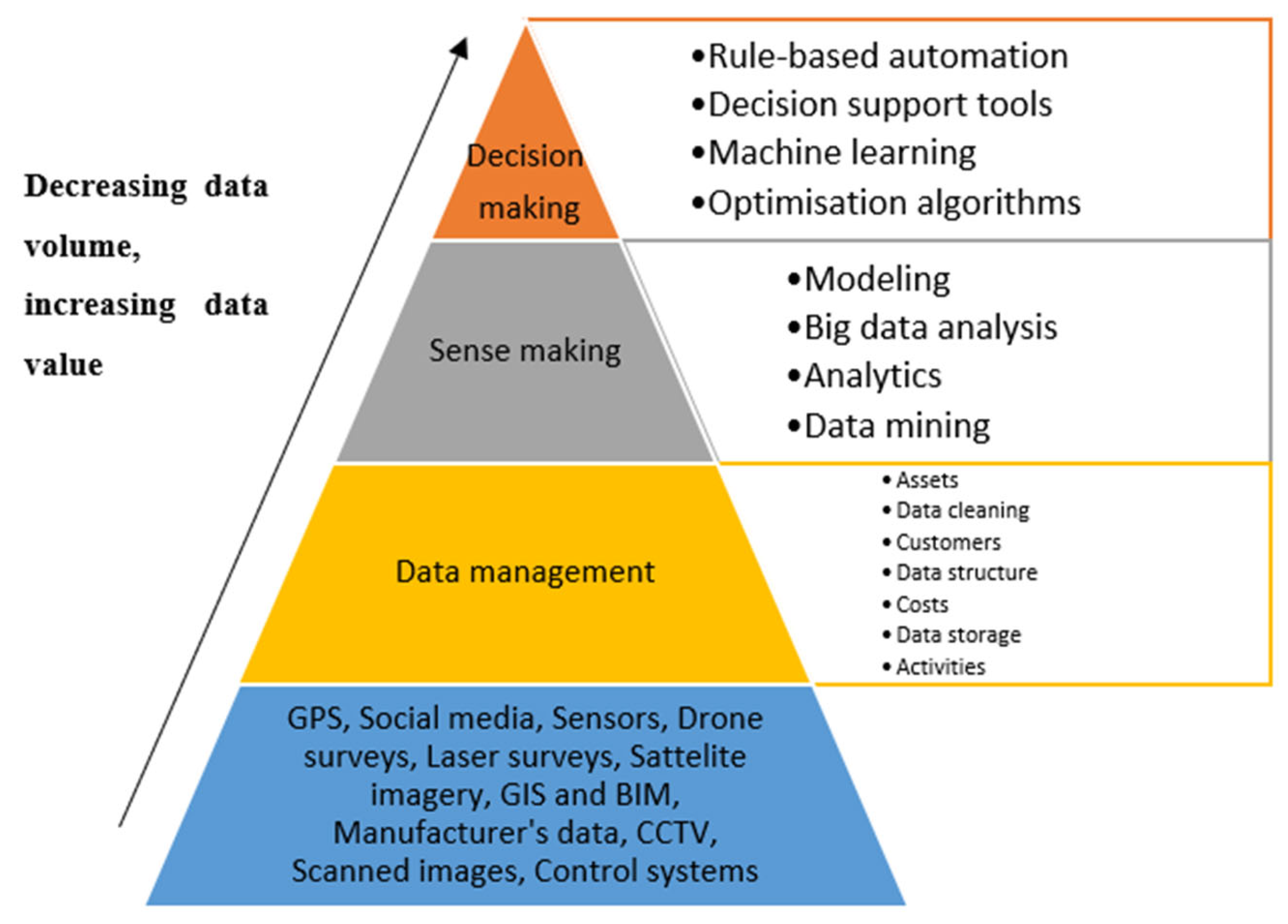
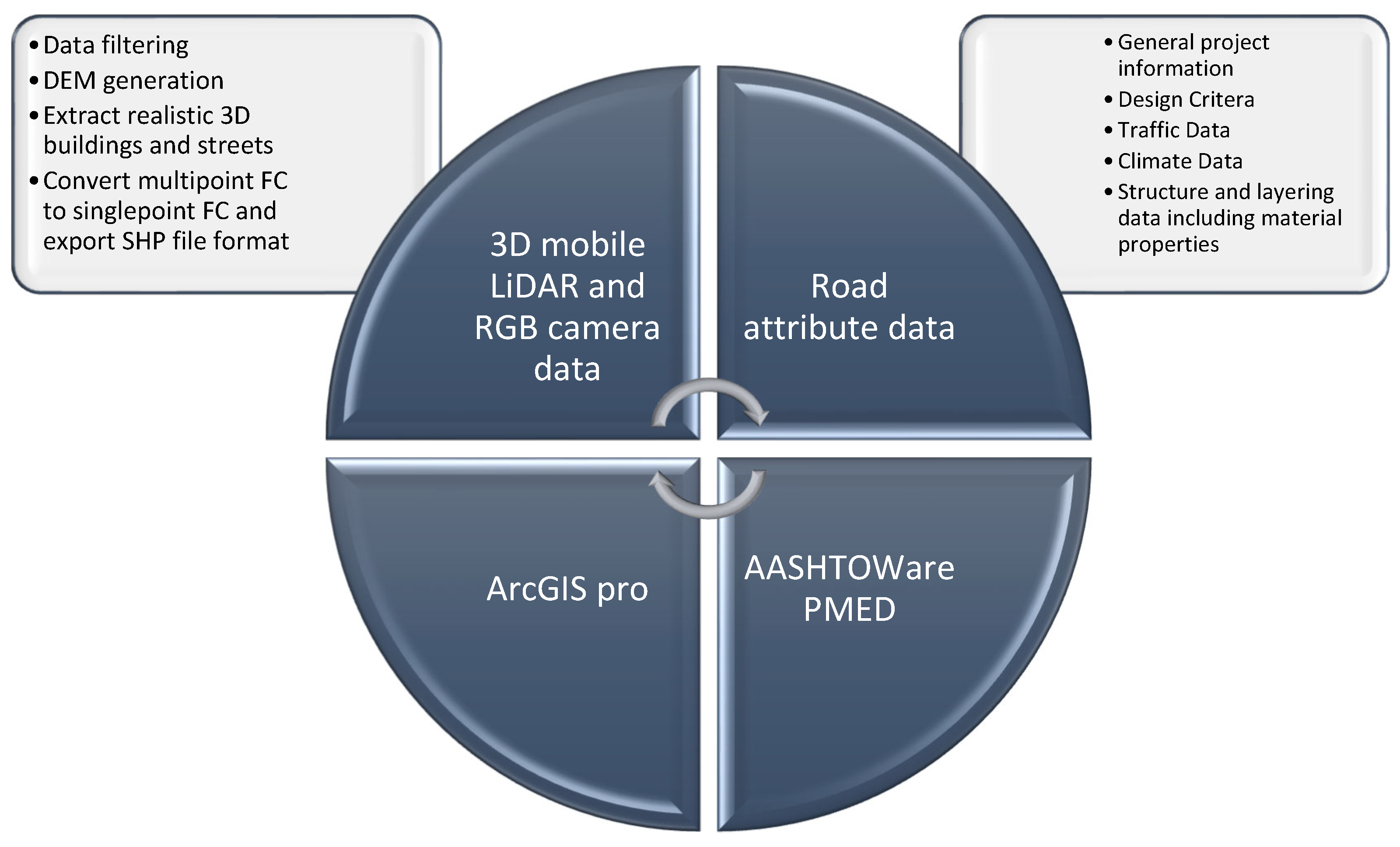
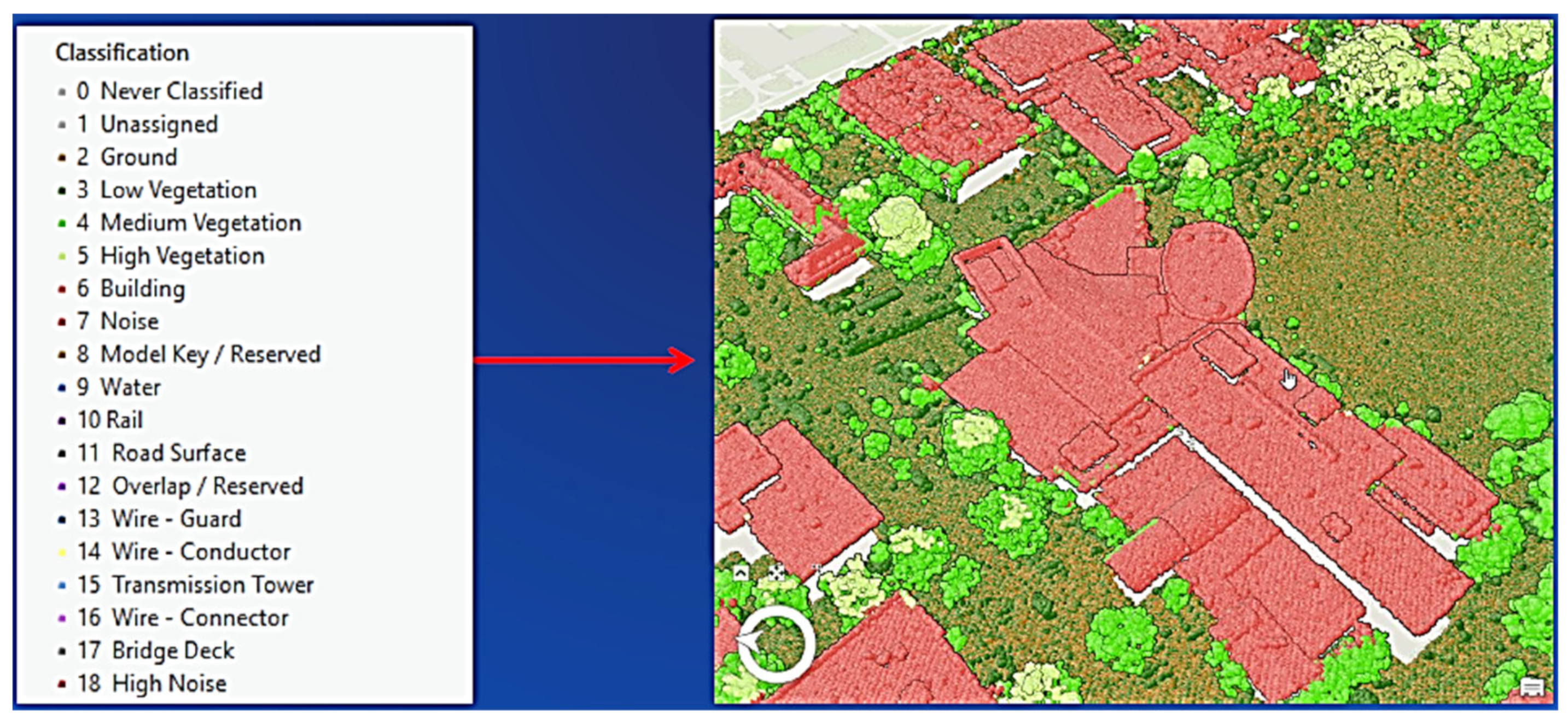

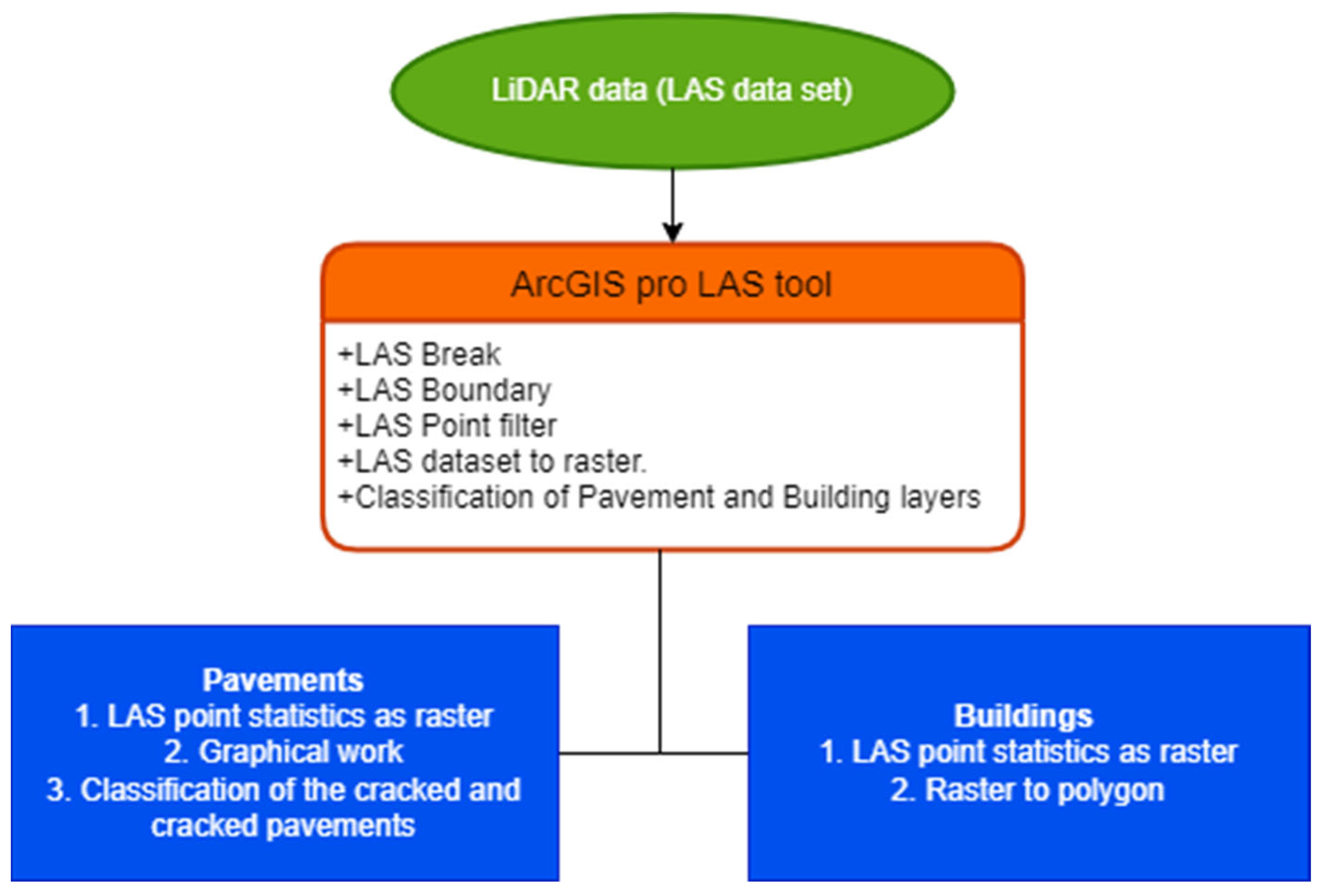
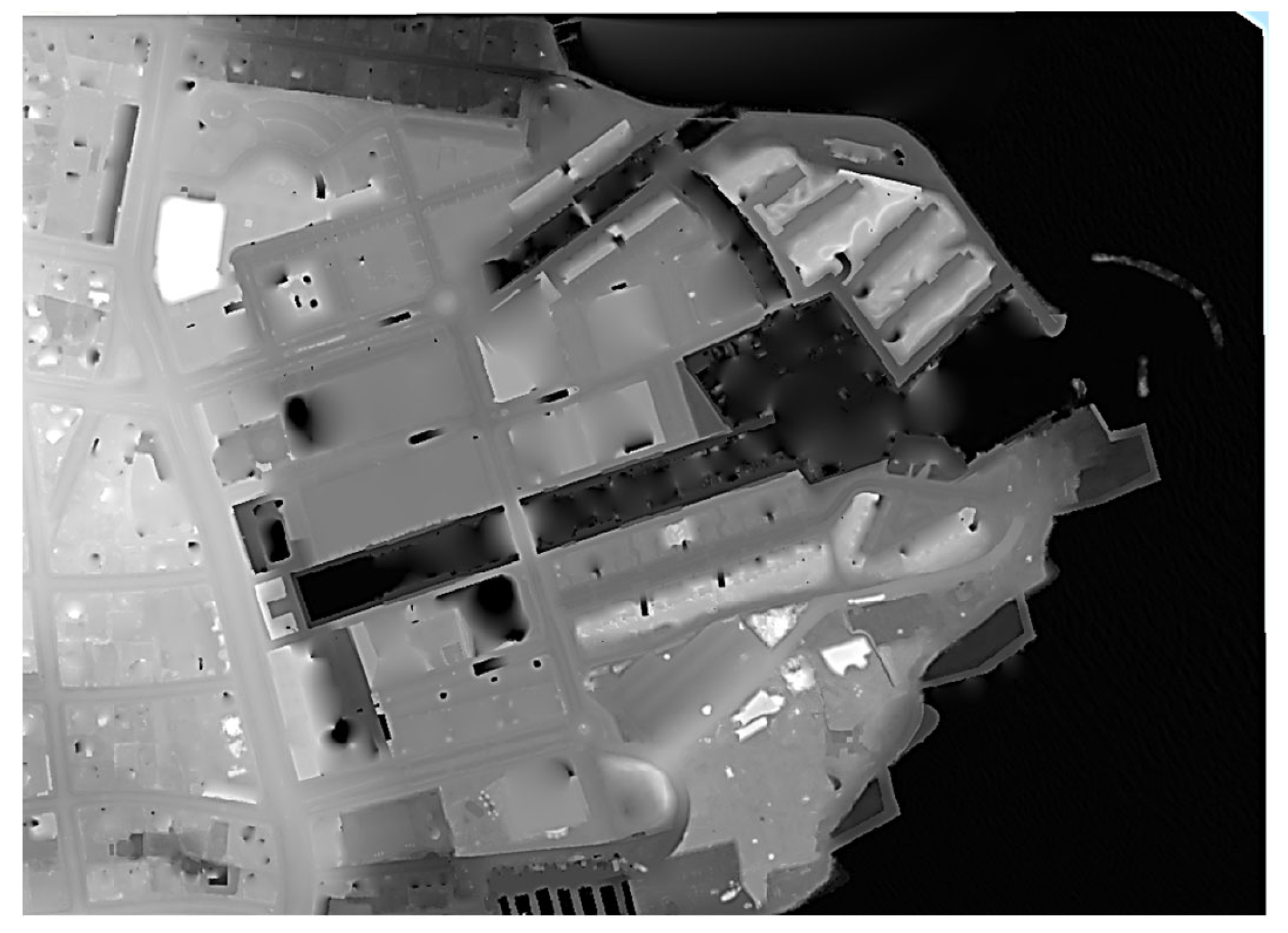
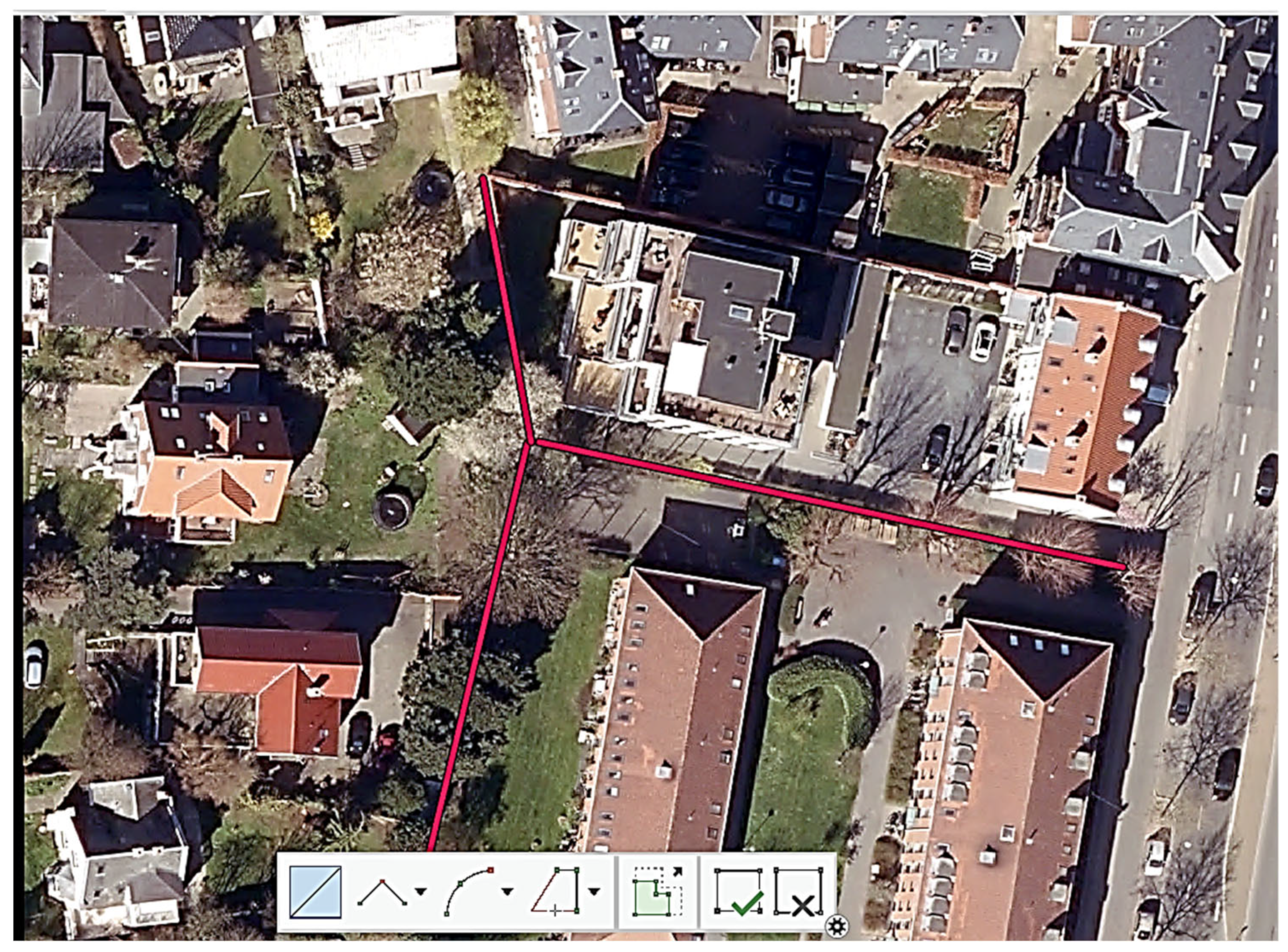
| Specifications | 3D LiDAR (Ouster OS-1 16ch) |
|---|---|
| 3D points/profile | 200 to 400 (4 m Field of View (FoV)) |
| Car’s velocity | 70–100 km/h |
| Distance between profiles | 7–15 cm |
| X-axis resolution | 1.1 to 2.4 cm |
| Lateral FoV | Up to 100 m |
| Precision on the Z-axis | 3 cm |
| Frequency of sampling | 160–320 profiles/s |
| Asset inventory and maintenance management module (1) | Asset inventory and data collection | Asset performance modeling module (2) | Asset deterioration forecasting functions | DSS module (3) | Decision scenario generator | Intelligence and reporting module (4) | Interactive data postprocessing and visualization tools |
| Asset inspection and maintenance management | Optimizer (solver) | ||||||
| GIS |
Disclaimer/Publisher’s Note: The statements, opinions and data contained in all publications are solely those of the individual author(s) and contributor(s) and not of MDPI and/or the editor(s). MDPI and/or the editor(s) disclaim responsibility for any injury to people or property resulting from any ideas, methods, instructions or products referred to in the content. |
© 2023 by the authors. Licensee MDPI, Basel, Switzerland. This article is an open access article distributed under the terms and conditions of the Creative Commons Attribution (CC BY) license (https://creativecommons.org/licenses/by/4.0/).
Share and Cite
Moradi, M.; Assaf, G.J. Designing and Building an Intelligent Pavement Management System for Urban Road Networks. Sustainability 2023, 15, 1157. https://doi.org/10.3390/su15021157
Moradi M, Assaf GJ. Designing and Building an Intelligent Pavement Management System for Urban Road Networks. Sustainability. 2023; 15(2):1157. https://doi.org/10.3390/su15021157
Chicago/Turabian StyleMoradi, Maryam, and Gabriel J. Assaf. 2023. "Designing and Building an Intelligent Pavement Management System for Urban Road Networks" Sustainability 15, no. 2: 1157. https://doi.org/10.3390/su15021157
APA StyleMoradi, M., & Assaf, G. J. (2023). Designing and Building an Intelligent Pavement Management System for Urban Road Networks. Sustainability, 15(2), 1157. https://doi.org/10.3390/su15021157











